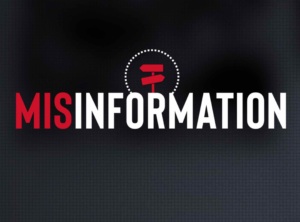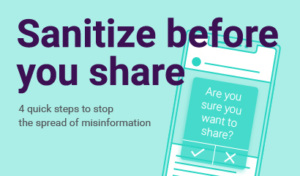News Lit Quiz: Should you share it? Education edition
Fighting falsehoods on social media
The quiz embedded below measures how you know social media platforms’ policies designed to stem falsehoods from flooding your newsfeed. Different tech companies take different approaches, with some being more vigilant than others. In addition to implementing and enforcing their own policies, some platforms allow you to report misleading posts or provide information about the people and/or organizations that manage the page, including where they are located, when the page was created, whether the page has had other names, and whether it is running ads?
More important than ever
We have seen just how important such policies and tools are in 2020, with plenty of misinformation circulating about COVID-19, racial justice protests, wildfires and the presidential election.
For example, when you search “coronavirus” or “COVID-19” on certain platforms —you’ll learn which ones in the quiz — post from authoritative health sources or standards-based news organizations are prioritized at the top of the results. One social media platform has a “medical misinformation” option in its content reporting menu, and others are expected to follow suit.
Different approaches to political advertising
Falsehoods, rumors and manipulated content about elections, campaigns and politicians are nothing new, and some companies are working to keep such misleading content off their platforms. And one tech company banned political ads last fall, arguing that the reach of political messages should not be bought through internet advertising. But another online giant has taken a lenient approach to political advertising. Its policy has exempted politicians’ posts and ads from the company’s third-party fact-checking program because they are considered “newsworthy” even if they are untrue.
So take this quiz and see how much you know about the social media sites that you visit and the measures they are taking to protect the public. You might be surprised by how much you know or don’t know!
Five types of misinformation
 The term “fake news” once referred to misinformation designed to look like legitimate news, but the term has been rendered meaningless and counterproductive through overuse and political weaponization. The reality is that different kinds of misinformation vary significantly in their tactics, intent and impact. Therefore, to better understand misinformation, we need a new vocabulary that helps us see and think about these differences.
The term “fake news” once referred to misinformation designed to look like legitimate news, but the term has been rendered meaningless and counterproductive through overuse and political weaponization. The reality is that different kinds of misinformation vary significantly in their tactics, intent and impact. Therefore, to better understand misinformation, we need a new vocabulary that helps us see and think about these differences.
The poster linked below identifies and defines five types of misinformation:
- Satire
- False context
- Impostor content
- Manipulated content
- Fabricated content
Definitions and examples of each type of misinformation are included in the poster linked below. This poster was adapted from the “Misinformation” lesson on our Checkology® virtual classroom. Use it with that lesson or on its own.
Sanitize before you share
 Misinformation swirling around the COVID-19 pandemic underscores the importance of consuming and sharing online content with care.
Misinformation swirling around the COVID-19 pandemic underscores the importance of consuming and sharing online content with care.
Public health officials are urging us to practice good hygiene to help stop the spread of this virus — by washing our hands thoroughly and frequently, staying home as much as possible, and keeping a safe distance from others when we do go out.
We can also practice good information hygiene.
Just adopt the four quick and easy steps below to help stop the spread of COVID-19 misinformation. If we sanitize the process around our information habits, we can prevent misleading and false content — some of which is hazardous to our health — from being widely shared and potentially doing harm.
Get smart about COVID-19
Each of us needs to play a role in combating misinformation about the ongoing COVID-19 pandemic. When the outbreak hit the U.S. in spring, NLP created resources to provide the public, educators and students with accurate information about the illness.
We also created a quiz to test whether you can sort fact from fiction related to COVID-19 information. The World Health Organization called this deluge of information and misinformation about the pandemic an “infodemic’ for good reason.
Test your knowledge
The quiz embedded below will test your ability to accurately categorize information using a compilation of examples pulled from several sources. You will see news clips, social media posts, images, video, and charts and graphics. Then you must determine whether the content is opinion or news, is supported by valid evidence or whether the source cited is reliable.
If you have been paying attention to news about the pandemic these many months, you might find that some of the examples are easy. Yet others just might trip you up. Remember, this virus poses an ongoing and serious public health challenge. Since it appears COVID-19 will be with us for a while, it’s important to keep your skills sharp when it comes to determining what to trust, share or act on.
Your health and the health of your friends and family might just depend on it.
Should you share it?
When a news event or a significant issue grabs hold of the public’s attention, it’s human nature for us to want to get our hands on as much information as we can as fast as we can. It’s also human nature to act on an impulse to share that information with friends, family and the wider community in an effort to keep people safe from harm.
Unfortunately, large breaking news events — especially those connected to controversial, frightening and complex subjects, like the current COVID-19 pandemic — tend to generate a spike in viral rumors. These stories, anecdotes, ads and memes pass quickly from one person to the next, often with little regard to whether the content is true. Some elements may be accurate, but much is simply a form of digital rumor — half-truths, doctored videos and images, or complete fabrications.
Check your emotions and think critically
They typically appeal to our emotions, provoking anger, fear, curiosity or hope and overriding our rational minds and critical-thinking skills. When we have an immediate strong response to a piece of content online, our impulse is to take action: to “like” it, to share it immediately, to express whatever we’re feeling about it. Because of that impulse, and because Twitter, Facebook, Instagram, YouTube and other platforms effortlessly connect us to thousands of people (many of whom we’ve never even met), this content spreads rapidly across social media — even from one platform to another.
So think of these rumors like an actual virus. Mike Baker, a New York Times reporter in Seattle, has been tweeting weekly about the exponential increase in confirmed COVID-19 cases in the United States. A “like,” share or retweet of false or unverified content on social media spreads the same way — and the numbers are considerably larger.